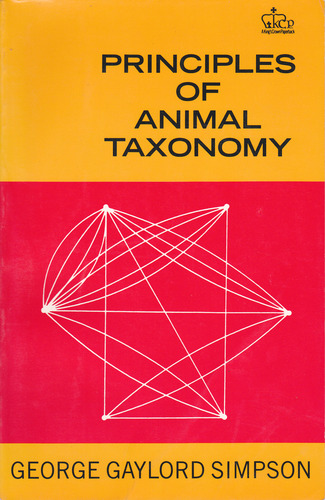Principles of animal taxonomy pdf
Par ayers patrick le lundi, janvier 9 2017, 01:52 - Lien permanent
Principles of animal taxonomy. George Gaylord Simpson

Principles.of.animal.taxonomy.pdf
ISBN: 023109650X,9780231096508 | 131 pages | 4 Mb

Principles of animal taxonomy George Gaylord Simpson
Publisher: Columbia University Press
Simpson GG (1961) Principles of Animal Taxonomy. The principle behind the method is illustrated in Figure 1, which shows a single species splitting into two independently evolving populations that gradually diverge over time. The same principle has been applied to understand the enormously diversified biological organisms, mainly animals and plants. Why do nursery tales allow wild animals to act in a human fashion? Each question in e-asTTle has been assigned a level from the SOLO taxonomy. Many fast food joints depend on this principle. What does this tell us about the kind of person she is? Extended abstract: the student is making connections not only within the given subject area, but also beyond it, able to generalise and transfer the principles and ideas underlying the specific instance. The basic method of classifying the organisms has been the taxonomy. This method of classification has changed over time to reflect and accommodate current thinking in science, but primarily the principle has remained unchanged, grouping animals based on shared characteristics. Introduction Biology as a science, put the various organisms as its object of study. Tylodes as a cnidarian, or jellyfishlike creature, was wrong, the researchers report today (Jan. This has then been further his chair, and sleeps in his bed. Hunn [13] Our objective, in this study, is to record the fishers' knowledge in relation to cetaceans, with special emphasis on folk taxonomy (ethnotaxonomy), analyzing fishers' forms of classification and nomenclature of whales and dolphins in the Southeastern Brazilian coast. The research reveals That gut proved that the previous classification of C. By: Stephanie Pappas, LiveScience Senior Writer Published: 01/17/2013 10:07 AM EST on LiveScience An ancient sea animal that looked like a flower had its anus right next to its mouth, a new fossil study finds. The process of classifying and giving names to plants and animals was extensively studied by Berlin [3] who defines general principles to ethnobiological categorization and nomenclature.